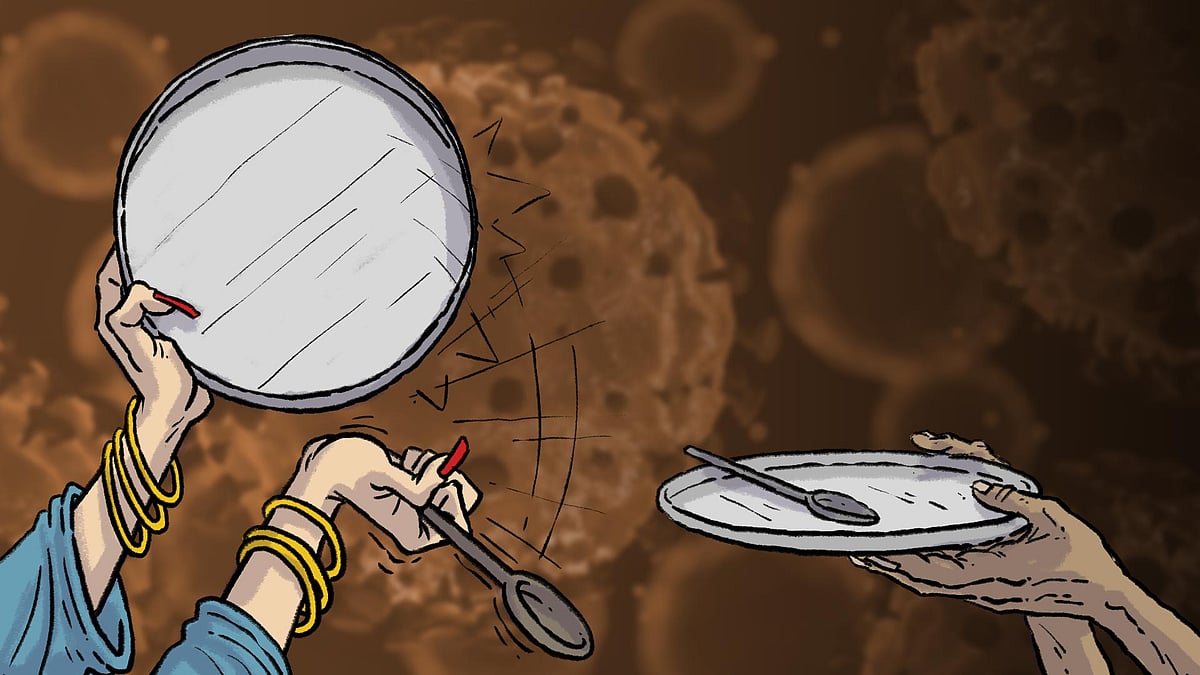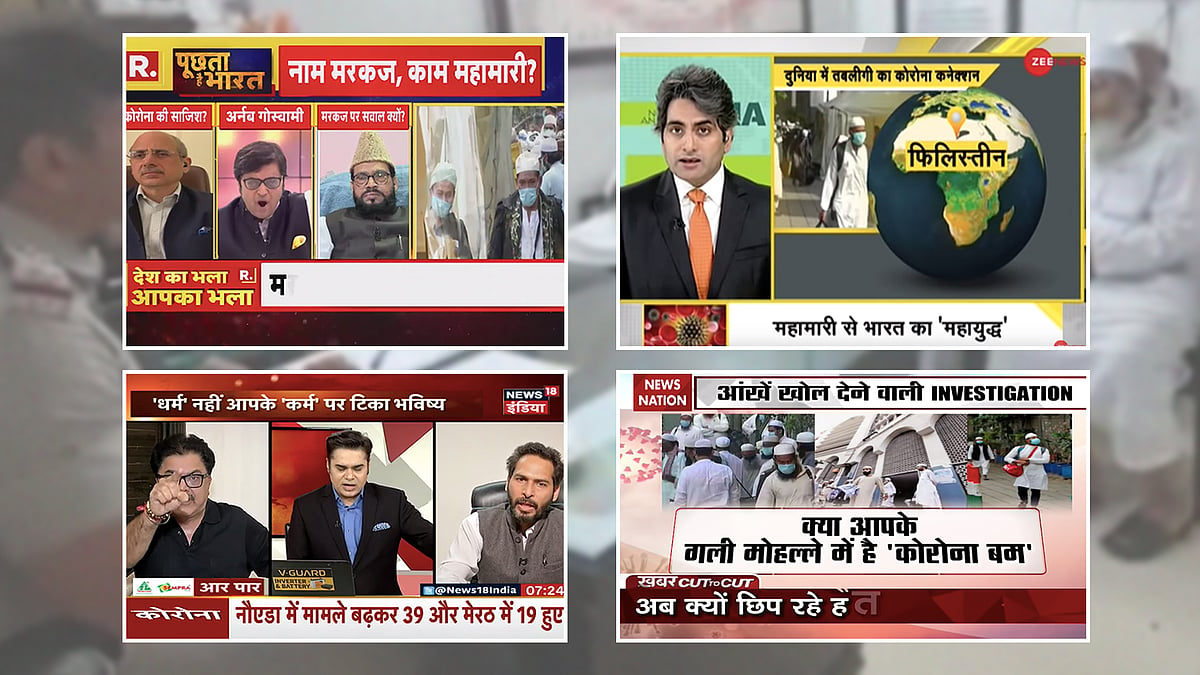Coronarage: The virus of aaakh thoo is the new normal in coronavirus spread
How can we put out the communal fire? By shedding the abuse that has deluged us, we lose our pain and reclaim the generosity of the human spirit.
Coronarage has spread with as much speed as Covid-19. We are engulfed. A vituperative-laden cyclone hovering and landing only to rise again. We are diverted and sidetracked from the core of Covid-19 that we should be concentrated on. After the Tablighi Jamaat incident, varying facts unleashed furious arrows from all sides. The truth evolved into an intangible and amorphous form. The truth bent according to your religious belief. The truth depended on your political position. Your social position. Your anger with people who took social distancing too lightly and carried on with religious congregations, Hindus, Muslims and Jains. Watching a bully beat up a young man because of his religion. Anger when a shop owner refused to sell to a particular community. There is a wave of coronarage rising from hunger, unemployment, no salaries, fear, isolation and the humiliation of daily wagers.
Yes, I plead guilty to responding insensitively to a tweet. Mistakenly, I thought it was humorous. No, it wasn’t. Not at this time of volatility. Social media has always been littered with abuse but it has recently stumbled to the highest low with the use of the language of aaakh thoo and thookers as the new normal. The rising climate of incivility only emboldens hate groups and widens divisions in our country. How can this be good for any one of us? Do the social media voices reflect what is the reality on the ground or does it lead and influence thoughts and beliefs? Probably both.
The groupings on social media mirror the physical. Fan clubs on social media are possibly a duplicate of fan clubs pre-social media. Lynch mobs online are also clones of lynch mobs in the real world. If indeed, it does influence a direction of mass thinking, perhaps it is time to reflect on what impact it is having. The Washington Post reported, “Several incidents in recent years have shown that when online hate goes offline, it can be deadly. White supremacist Wade Michael Page posted in online forums tied to hate before he went on to murder six people at a Sikh temple in Wisconsin in 2012. Prosecutors said Dylann Roof ‘self radicalized’ online before he murdered nine people at a black church in South Carolina in 2015. Robert Bowers, accused of murdering 11 elderly worshipers at a Pennsylvania synagogue in October, had been on Gab, a Twitter-like site used by white supremacists.” We do not need this.
When His Holiness the Dalai Lama was asked if he hated the Chinese, he answered, “No, because hate is not functional.” Is the social media abuse-laden war functional for us? Is it helping us fight the immediate war against Covid-19? The disease is not selecting its victims based on religious or political affiliations. It is targeting us all.
Do we want to live in a country where a Hindu walks in fear in a Muslim neighbourhood? Do we want a country where a Muslim is denied admission in a hospital? Do we want to institutionalise inhumanity? By fanning the flames we will only burn ourselves. How is it practical? We have enough problems with financial and social inequities, medical facilities and education not available to all, why would we want to make it even more difficult for ourselves by adding an unnecessary element that actually creates impediments to development?
On this issue, the abuse teams on both sides are humongous. Perhaps, a look at the chronological flow will show the forces that led to this crack becoming a deep fracture. The first Covid-19 case in India, a student who had returned from Wuhan, was reported in Kerala on January 30. By April 14, at least 10,000 cases had been reported across the country. A Sikh granthi who travelled from Italy and Germany turned into a super-spreader when he attended the Hola Mohalla festival in Anandpur Sahib between March 10 and 12. Twenty seven Covid-19 cases were traced back to him. Over 40,000 people in 20 villages in Punjab were quarantined on March 27, to contain the spread.
To be noted here, not a single television anchor attacked the Sikh religion despite the government cautioning the priest who had returned from Italy and Germany to self-quarantine. He ignored all advice to self-isolate and went on to become a super-spreader, attending several religious gatherings of thousands of people. The Golden Temple remains open. Visitors are sprayed with a hand sanitiser but are noticeably without masks. No outrage from television anchors. I am not suggesting it. This YouTube video is dated March 17, 2020 by the Hindustan Times.
How the news media reported and communalised the Tablighi Jamaat case was vastly different.
By March 31, the Tablighi Jamaat had emerged as the second super-spreader after around 9,000 people reportedly attended a congregation, 960 of them from 40 foreign countries. Below are examples of two straight reports without any communal colour.
Coronavirus: Search for hundreds of people after Delhi prayer meeting
How Nizamuddin markaz became Covid-19 hotspot; more than 8,000 attendees identified
When the Nizamuddin West area was declared a hotspot, Amir Maulana Saad, head of the Tablighi Jamaat, conducted himself in an irresponsible manner. Saad asked his followers to ignore social distancing norms and to stay in the mosque. He said social distancing was anti-Islamic. This led to the media exposing him.
If Saad had advised his followers to isolate and get tested, we would have a different story to tell. After this, Saad went into hiding. His disciples followed his lead and avoided testing. Because of the lack of trust and fear the Muslim community feels towards the police and the authorities, many understandably believe volunteering to test is a tricky option. So what came first? The chicken or the egg? The ill-treatment and fear, or irresponsible behaviour and a communal angle? The TV anchors who went on a rampage with debates such as #CoronaJihad. Take a look.
What if journalists had stuck to reporting the story straight without adding the communal angle? What if they had not lumped together all Muslims as super-spreaders? What if stories had been done that urged the Tablighi Jamaat followers to come out and be tested? What if the police, the prime minister and chief ministers had assured them that they were not in danger and would be treated well, and sent that message to police as well. Why did the Jamaat fall into their own trap by living up to a stereotype? Numerous Muslim leaders repeatedly called out to them to emerge and be tested. Finally, Saad also called out to them, albeit extremely late. But instead of giving this maximum coverage, the media largely ignored these calls. The media carried on relentlessly highlighting the communal angle.
There was coronarage spiralling from people who resented the Jamaat’s super-spreader behaviour fuelled by hateful primetime shows on news channels, and their abuse also super-spread. In response to that, ordinary Muslims reacted with indignant, abusive diatribes. For every anchorperson’s report that fed the anti-Muslim frenzy, there was a violent reaction on social media. Each side actually began to feed each other and push the insult buttons.
What can be done? What if these teams agreed to call a truce? Is it a useless, naïve proposition? What are the choices? We could go on with the animus, which would translate into more monstrosities in the real world. Or, we could use the same energy, brains and time to channelise what we can do to help in this emergency.
Other countries have overcome far greater animosities between communities to save themselves. The Truth and Reconciliation Commission in South Africa (1996), although controversial, actually prevented a bloodbath of revenge. The TRC was formed to look into the crimes committed during the apartheid era and offer platforms for victims and their families to confront the perpetrators, who in turn were offered amnesty for coming forward. Archbishop Desmond Tutu and Nelson Mandela asked the impossible of their people. Mandela said, “Courageous people do not fear forgiving, for the sake of peace.”
At the TRC, coming face to face with someone who had tortured and murdered your son, husband, daughter, sister, listening to their confessions and then forgiving them? Needless to say, some did not forgive but they did not go outside the law. Unlike the Nuremberg Trials, which was Retributive Justice, this was Restorative Justice. What looked like a crazy idea in the beginning somehow worked.
What can we do?
Journalism should go back to the old norms of not identifying communities. It was a rule observed for riots. This can be applied for Covid-19.
Switch off channels that identify and vilify communities. Switch off channels that carry debates, rather shouting matches, that set communities against each other.
Let your disapproval of divisive stories be known in comments sections of websites and news channels on YouTube. Stop communalising.
Faith-based communities must focus on the role they can play to enhance assistance to those suffering because of Covid-19.
Encourage your own communities to come out and get tested.
Spread messages that testing is for their own good and urge them to welcome health workers.
Do not forward or retweet any message that abuses any community. Do not give it oxygen.
Appeal to the same groups on your timeline (previously spewing abuse) to coordinate relief efforts for those who need food and medicine.
Seek to transform and not respond in kind to a hate-filled tweet. #DoNotCommunalise. Otherwise, report the tweet.
Unfollow and/or block all Twitter handles that post divisive, hate filled messages.
Prime Minister Narendra Modi has shown strong leadership in this crisis. Could the prime minister challenge his animus towards one community and go from strong to great, history creating leadership? A reverse dog whistle would be highly effective. Our survival depends on syncretism. In social distancing, we have also moved towards compassion distancing. In morphic resonance, we have become part of the insults and mockery that have deluged us. By shedding it we have nothing to lose but pain, only to emerge as what has fast become an endangered species: a good human being. Citizens have to be part of nation-building. This is your opportunity. Your call.
 The Samandar Manthan of 2020: It’s not Right vs Left or Hindu vs Muslim. It’s the privileged vs the poor
The Samandar Manthan of 2020: It’s not Right vs Left or Hindu vs Muslim. It’s the privileged vs the poor
 Coronavirus and Nizamuddin: TV news returns to bigotry with a bang
Coronavirus and Nizamuddin: TV news returns to bigotry with a bang
